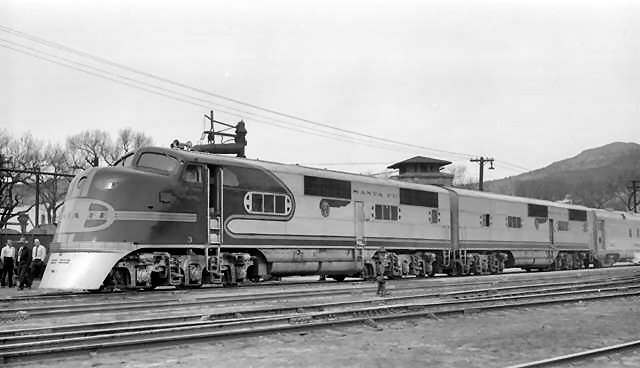- EMD E1
Infobox Locomotive
name=EMD E1
powertype=Diesel-electric
gauge=RailGauge|ussg

caption=ATSF #3 and #3A atRaton, New Mexico , showing off its "Warbonnet" paint scheme. This AB pair was bought as standby power for the streamlined "Super Chief " trainsets, but soon pressed into regular service.
poweroutput=convert|1800|hp|abbr=on|lk=on
aarwheels=A1A-A1A
builder=General Motors Electro-Motive Division (EMD)
builddate=1937–1938
railroad=Atchison, Topeka and Santa Fe Railway
totalproduction=8A unit s, 3B unit s
primemover=Winton 201-A, 2 off
roadnumber=2–9 (A units), 2A–4A (B units)The EMD E1 was an early passenger-traindiesel locomotive developing 1,800 hp, with an A1A-A1Awheel arrangement , and manufactured by General Motors Electro-Motive Division ofLa Grange, Illinois . They were built during1937 and1938 for theAtchison, Topeka and Santa Fe Railway for a new generation of diesel-powered streamlined trains. 8 cab-equipped leadA unit s and three cabless boosterB unit s were built. The initial three locomotives were AB pairs built to haul the Santa Fe's "Super Chief " diesel streamliners, while the others were built as single A units to haul shorter trains. The locomotives werediesel-electric s with two 900 hp Winton 201-A engines each, with each engine driving its own generator to power thetraction motor s. The E1 was the second model in a long line of passenger diesels of similar design known asEMD E-units . All Winton 201A-engined Santa Fe passenger units, including the E1's, were extensively rebuilt into the 80-class E8M engines in 1952-53. These were similar to production E8 models, but derated to 2000 hp so as not to burn out the early traction (axle) motors (which were reused).Significance and influence
The E1—along with the more-or-less simultaneous EA/EB for the
Baltimore and Ohio Railroad and the E2 for theUnion Pacific Railroad ,Chicago and North Western Railway andSouthern Pacific Railroad —represented an important step in the evolution of the passenger diesel locomotive. While the EA, E1 and E2 were each built for a specific railroad, they were largely identical mechanically and were a step further away from the custom-built, integratedstreamliner and towards mass-produced passenger locomotives—a step achieved with the E3, E4, E5, and E6, EMD's next models. These locomotives are definitely related in an evolutionary manner with all EMD's future passenger models.Styling
The EA/EB and E1 featured largely identical and innovative styling showing the influence of the Electro-Motive Corporation's new buyer General Motors. While mechanically they had much in common with previous, experimental EMC locomotives, GM understood the importance of looking new and exciting, not merely being technically innovative. This basic "slant nose" style was continued in the subsequent E3, E4, E5 and E6 models, while a more "bulldog nose" style was tried in the E2 and a style somewhere in between was used for the E7, E8 and E9, as well as the freight diesel
cab unit s. It could fairly be said that the overall styling influenced passenger locomotives around the world.The "shovelnose" styling was modified on later models because the streamlined headlight was found less satisfactory than more common types with vertical lenses, and the elegantly sloped nose had a bad habit of deflecting vehicles up toward the cab in a grade crossing collision. More enduring was the paint scheme--E1 number two and her booster #2A were the first locomotives to wear the world-famous Santa Fe "Warbonnet" red and silver colors. In fact, these units used stainless steel sides on the carbody to better match the road's new stainless passenger cars. Interestingly, this decor was not developed by the Santa Fe, but by EMD--or rather, by GM's Art and Color section.Numbers and assignments
Each E1 was initially ordered for and assigned to a particular train. The ATSF practice was to give all locomotive units in a set the same number, distinguished by letter. The lead unit was designated 'L', but this was not carried on its numberboards. The second unit was 'A'; subsequent units were 'B', 'C', if present. This numbering was part of the railroads' ultimately successful campaign to convince the railroad unions that a multiple-unit diesel locomotive should be considered one locomotive of several parts (and thus needing only one crew) rather than multiple locomotives requiring multiple crews under union agreements.
* 2 and 2A - for the original streamlined "Super Chief ".
* 3 and 3A - for the second streamlined "Super Chief" trainset.
* 4 and 4A - backup power for the "Super Chief".
* 5 - for the "El Capitan".
* 6 - for the "El Capitan".
* 7 - for the "San Diegan ".
* 8 - for the "Golden Gate".
* 9 - for the "Golden Gate".References
*
* Anderson, Norm. "Santa Fe Passenger Diesels". Posting on Railfans.net forums,May 1 ,2004 . Retrieved from [http://forums.railfan.net/forums.cgi?board=ATSF;action=display;num=1083466236 Railfan.net Forums] onDecember 22 ,2004 .External links
* [http://www.northeast.railfan.net/diesel99.html Photos at North-East Rails] , including a picture of the cab interior.
Wikimedia Foundation. 2010.
